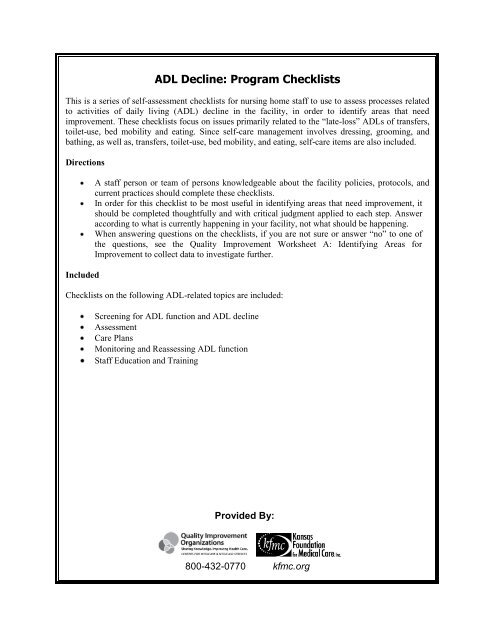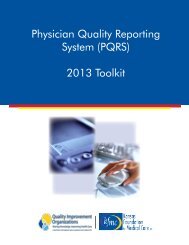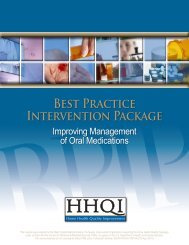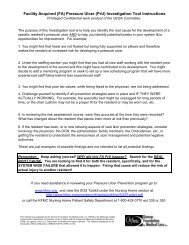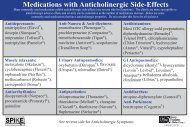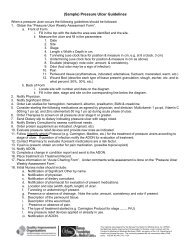ADL Facility Assessment Checklists - Kansas Foundation for ...
ADL Facility Assessment Checklists - Kansas Foundation for ...
ADL Facility Assessment Checklists - Kansas Foundation for ...
You also want an ePaper? Increase the reach of your titles
YUMPU automatically turns print PDFs into web optimized ePapers that Google loves.
<strong>ADL</strong> Decline: Program <strong>Checklists</strong>This is a series of self-assessment checklists <strong>for</strong> nursing home staff to use to assess processes relatedto activities of daily living (<strong>ADL</strong>) decline in the facility, in order to identify areas that needimprovement. These checklists focus on issues primarily related to the “late-loss” <strong>ADL</strong>s of transfers,toilet-use, bed mobility and eating. Since self-care management involves dressing, grooming, andbathing, as well as, transfers, toilet-use, bed mobility, and eating, self-care items are also included.DirectionsIncludedA staff person or team of persons knowledgeable about the facility policies, protocols, andcurrent practices should complete these checklists.In order <strong>for</strong> this checklist to be most useful in identifying areas that need improvement, itshould be completed thoughtfully and with critical judgment applied to each step. Answeraccording to what is currently happening in your facility, not what should be happening.When answering questions on the checklists, if you are not sure or answer “no” to one ofthe questions, see the Quality Improvement Worksheet A: Identifying Areas <strong>for</strong>Improvement to collect data to investigate further.<strong>Checklists</strong> on the following <strong>ADL</strong>-related topics are included:Screening <strong>for</strong> <strong>ADL</strong> function and <strong>ADL</strong> decline<strong>Assessment</strong>Care PlansMonitoring and Reassessing <strong>ADL</strong> functionStaff Education and TrainingProvided By:800-432-0770 kfmc.org
Checklist: Screening <strong>for</strong> <strong>ADL</strong> Function and <strong>ADL</strong> DeclineDoes your facility have a process to screen residents’ <strong>ADL</strong> function?(An <strong>ADL</strong> screening process should be brief (~15minutes or less). If a resident requires more in-depth assessment,then a comprehensive evaluation by the appropriate clinical discipline should be per<strong>for</strong>med.)______ No. If no, this is an area <strong>for</strong> improvement. Use this checklist and the Quality ImprovementWorksheets to guide your team in implementing a process <strong>for</strong> screening <strong>ADL</strong> function amongresidents.______This is an area we are working on. Our target date <strong>for</strong> revising our process <strong>for</strong> screening <strong>for</strong><strong>ADL</strong> function is __________. If needed, use the Quality Improvement Worksheets to guide yourimprovement process.______Yes. Please continue to the questions below.Does your facility’s process <strong>for</strong> screening <strong>for</strong> <strong>ADL</strong> function include the following components?Yes No1. Does your facility have a policy and procedure <strong>for</strong>when, how, and who will screen residents <strong>for</strong> <strong>ADL</strong>function and <strong>ADL</strong> decline? Y N2. Does your facility screen the residents’ <strong>ADL</strong>function:a. Upon admission?b. Upon readmission?c. With any significant change in condition and/orchange in <strong>ADL</strong> functional ability?d. With each MDS assessment?3. Does your facility use a validated, standardizedmeasure of <strong>ADL</strong> function? (Examples: MDSscores, Katz <strong>ADL</strong> Scale, Barthel Index)4. If a significant change in <strong>ADL</strong> status is identified,does your facility have a process leading to acomprehensive assessment of the resident’s <strong>ADL</strong>function if needed?If any of the above elements in your process are missing:YYYYYYNNNNNNPersonResponsible:Comments:• Choose one element to focus your quality improvement ef<strong>for</strong>t on first.• Start with the Quality Improvement Worksheet A: Identifying Areas <strong>for</strong> Improvement to collect datato investigate further.• Follow the Quality Improvement Worksheets to implement missing element(s) and monitor regularlyto determine whether implementation is successful.If none of the above elements are missing from your facility’s processes, please continue to the nextchecklist.
Checklist: <strong>ADL</strong> <strong>Assessment</strong>If your facility has an <strong>ADL</strong> assessment process, does it include the use of specific assessment <strong>for</strong>ms<strong>for</strong> <strong>ADL</strong> decline?______ No. If no, this is an area <strong>for</strong> improvement. Use this checklist and the Quality ImprovementWorksheets to guide your team in implementing a <strong>for</strong>m <strong>for</strong> assessing <strong>ADL</strong> function that includesthe key components.______This is an area we are working on. Our target date <strong>for</strong> revising our <strong>for</strong>m <strong>for</strong> assessing <strong>for</strong> <strong>ADL</strong>function is __________. If needed, use the Quality Improvement Worksheets to guide yourimprovement process.______Yes. Please continue to the questions below.Does your facility’s assessment <strong>for</strong>m include the following components?Yes No1. Reason <strong>for</strong> this assessment (new admission,MDS assessment, change in condition, other) Y N2. Prior level of <strong>ADL</strong> function (prior toadmission or at time of last screen/assessment) Y N3. Current level of <strong>ADL</strong> functiona. Eating/Feeding (type of diet, liquid/solidconsistency, adaptive/assistive equip,positioning)b. Toilet use (toilet, bedside commode)c. Transfers (bed to chair, to wheelchair, tocommode)d. Bed Mobility (amount of assistanceneeded, adaptive equip)e. General mobility (ambulation, wheelchairmobility, amount of assistance needed,other)f. Gait (on level surfaces, stairs, ramps,uneven surfaces, use of assistive devices)g. Bathing (amount of assistance needed,adaptive equip)h. Grooming (amount of assistance needed,adaptive equip)i. Dressing (amount of assistance needed,adaptive equip)YYYYYYYYYNNNNNNNNNPersonResponsible:Comments:
Checklist: <strong>ADL</strong> <strong>Assessment</strong> (Cont.)4. Neuro-musculoskeletal:a. ROMb. Strengthc. Coordinationd. Loss of Balancee. Dizzinessf. History of fallsg. Sensation (touch, temperature, proprioception)h. Edemai. Vision, hearingj. Communicationk. Other (describe)5. Use of adaptive/assistive equipment:a. Orthosesb. ProsthesesYesc. OtherY N6. Pain Y N7. Communication ability Y N8. Cognition, alertness, orientation, safety awareness Y N9. Other health conditions & components that mayinfluence <strong>ADL</strong> functiona. Adverse drug reactionb. Total number of medications >3c. Aspirationd. Depressione. Deliriumf. Psychosisg. Fluid, electrolyte imbalanceh. Nutritional deficitsi. Skin breakdownj. Use of restraintsYYYYYYYYYYYYYYYYYYYYYYYNoNNNNNNNNNNNNNNNNNNNNNNNPersonResponsible:Comments:
Checklist: <strong>ADL</strong> <strong>Assessment</strong> (Cont.)10. Environmental factors:a. FurnitureYesb. Building (configuration, size of room)Y Nc. OtherY N11. Family Support, caregiver involvement Y N12. Customs, religious beliefs that may affect healthcare Y N13. Ability to learn:YNoNPersonResponsible:Comments:a. Barriers to participation/learning (vision, hearing,language, comprehension, memory, depression,interest…)b. Preferred learning style14. Current treatment interventionsa. Frequency, duration, time of dayb. Response to treatments15. Need to refer resident to other health professional<strong>for</strong> management of health components outside yourprofessional scope of practice?16. Follow-up recommendations:a. Revise current <strong>ADL</strong> goals, plan of careb. Refer to therapy <strong>for</strong> comprehensive assessmentc. Recommend equip, environmental modifications,etc.d. Initiate <strong>ADL</strong>/restorative programe. Continue current restorative programf. Discharge from <strong>ADL</strong>/restorative programg. Other (describe)YYYYYYYYYYYYNNNNNNNNNNNNIf any of the above elements in your process are missing:• Choose one element to focus your quality improvement ef<strong>for</strong>t on first.• Start with the Quality Improvement Worksheet A: Identifying Areas <strong>for</strong> Improvement to collect datato investigate further.• Follow the Quality Improvement Worksheets to implement missing element(s) and monitor regularlyto determine whether implementation is successful.If none of the above elements are missing from your facility’s processes, please continue to the nextchecklist.
Checklist: <strong>ADL</strong> Care PlansDoes your facility have a care planning process to improve/maintain <strong>ADL</strong> function and prevent orminimize <strong>ADL</strong> decline?______ No. If no, this is an area <strong>for</strong> improvement. Use this checklist and the Quality ImprovementWorksheets to guide your team in implementing a care planning process that includes the keycomponents.______This is an area we are working on. Our target date <strong>for</strong> revising our care planning process is__________. If needed, use the Quality Improvement Worksheets to guide your improvementprocess.______Yes. Please continue to the questions below.Do care plans <strong>for</strong> your facility's residents include the following components?Yes No1. Does the care plan include <strong>ADL</strong> goals (shorttermand long-term) as defined by theresident? Y N2. Does the care plan indicate:a. The specific cause of each deficitb. The type of interventions or treatments tobe per<strong>for</strong>medc. Frequencyd. Duratione. Amount of assistance requiredf. Equipment requiredg. Special positioning required5. Does the care plan include education of theresident and family related to theinterventions, <strong>ADL</strong> program, assistivetechniques, and use of adaptive/assistiveequipment to prevent decline?6. Does the plan indicate referrals made to otherhealth professionals, and reasons?7. Does the plan indicate when a reassessmentwill be completed?YYYYYYYYYYNNNNNNNNNNPersonResponsible:Comments:
Checklist: <strong>ADL</strong> Care Plans (Cont.)If any of the above elements in your process are missing:• Choose one element to focus your quality improvement ef<strong>for</strong>t on first.• Start with the Quality Improvement Worksheet A: Identifying Areas <strong>for</strong> Improvement to collect datato investigate further.• Follow the Quality Improvement Worksheets to implement missing element(s) and monitor regularlyto determine whether implementation is successful.If none of the above elements are missing from your facility’s processes, please continue to the nextchecklist.
Checklist: Monitoring and Reassessing <strong>ADL</strong> FunctionDoes your facility have a process to monitor and regularly reassess <strong>ADL</strong> function/abilities ofresidents currently in an <strong>ADL</strong> or restorative nursing program?______ No. If no, this is an area <strong>for</strong> improvement. Use this checklist and the Quality ImprovementWorksheets to guide your team in implementing a process to monitor and reassess <strong>ADL</strong> functionthat includes the key components outlined below.______This is an area we are working on. Our target date <strong>for</strong> revising <strong>ADL</strong> monitoring andreassessment process is __________. If needed, use the Quality Improvement Worksheets toguide your improvement process.______Yes. Please continue to the questions below.Does your facility’s monitoring and reassessment process include the following components?1. Does your documentation system allow you torecord:YesNoPersonResponsible:Comments:a. Current health condition, comorbidities thatmay influence functionYNb. Response to current interventionsYNc. Type of interventions, treatments providedYNd. Type of <strong>ADL</strong> per<strong>for</strong>med (eating, transfers)YNe. Level of self-per<strong>for</strong>manceYNf. Amount of assistance given by caregiverYNg. Devices/equip requiredYNh. Frequency <strong>ADL</strong>s per<strong>for</strong>med (daily, 3x/wk)YNi. Duration of activity (30 mins, etc.)YNj. Progress toward established goalsYNk. Cancellation, refusal of treatment and reasonYNl. Resident’s attitude toward <strong>ADL</strong> programYNm. Change in statusYNn. Need <strong>for</strong> reassessmentYNo. Need <strong>for</strong> referral to other health professionalto mange condition(s) outside yourprofessional scope of practiceYN2. Does your facility have a policy and procedure <strong>for</strong>reassessing residents at regular intervals afterthey have started a restorative program?YN
Checklist: Monitoring and Reassessing <strong>ADL</strong> Function (Cont.)3. Does your facility have a process <strong>for</strong> therestorative nurse aide or certified nurse aide tonotify an RN and rehab designee of a change inresident’s response to <strong>ADL</strong>s &/ or restorativeprogram?4. Does your facility discuss residents’ <strong>ADL</strong> statusand related issues at the interdisciplinary careplanning meeting?5. Does your facility reassess the resident when theresident or family expresses a concern regardinga change or decline in <strong>ADL</strong> abilities?YesYYYNoNNNPersonResponsible:Comments:If any of the above elements in your process are missing:• Choose one element to focus your quality improvement ef<strong>for</strong>t on first.• Start with the Quality Improvement Worksheet A: Identifying Areas <strong>for</strong> Improvement to collect datato investigate further.• Follow the Quality Improvement Worksheets to implement missing element(s) and monitor regularlyto determine whether implementation is successful.If none of the above elements are missing from your facility’s processes, please continue to the nextchecklist.
Checklist: Staff Education and TrainingDoes your facility have initial and ongoing education on <strong>ADL</strong> function and decline to both nursingand non-nursing staff?______ No. If no, this is an area <strong>for</strong> improvement. Use this checklist and the Quality ImprovementWorksheets to improve your staff education and training on <strong>ADL</strong> function and decline.______This is an area we are working on. Our target date <strong>for</strong> implementing an education program on<strong>ADL</strong> function and decline is:__________. If needed, use this checklist, current accepted clinicalguidelines and the Quality Improvement Worksheets to guide your facility’s education program.______Yes. Please continue to the questions below.Does your facility’s education program <strong>for</strong> <strong>ADL</strong> function and decline include the followingcomponents?1. Are nursing staff aware of current facilitypolicy (if there is one) <strong>for</strong> when, how, andwho:a. Screens residents <strong>for</strong> <strong>ADL</strong> function and<strong>ADL</strong> decline?b. Assesses residents <strong>for</strong> <strong>ADL</strong> function and<strong>ADL</strong> decline?c. Reassesses residents <strong>for</strong> <strong>ADL</strong> functionand <strong>ADL</strong> decline?d. Communicates results of screening andassessment to MDS coder?YesYYYYNoNNNNPersonResponsible:Comments:2. Are staff's learning needs with regard to <strong>ADL</strong>function and disability regularly assessed? Y N3. Does staff training address all healthcomponents influencing function anddisability (e.g., physiological, psychological,anatomical, functional, environmental, andsocial)?4. Does staff training on <strong>ADL</strong> managementoccur at orientation and at least quarterlythereafter?5. Does education staff provide disciplinespecificeducation <strong>for</strong> prevention of <strong>ADL</strong>decline (ex. Activities, Dietary, Rehab, SocialServices, etc.)?YYYNNN
6. Is there a designated clinical “expert”available at the facility to answer questionsfrom all staff about <strong>ADL</strong> function andrestorative programs?7. Is the education provided at the appropriatelevel <strong>for</strong> the learner (i.e. CNA vs. RN)?8. Does the education include staff training ondocumentation methods related to <strong>ADL</strong>decline?9. Are all staff aware of the process <strong>for</strong>identifying health conditions that mayinfluence functional ability?10. Are all staff aware of the environmentalfactors that can influence <strong>ADL</strong> function?11. Are appropriate staff trained on how to makereferrals to other health professionals whennecessary?YesYYYYYYNoNNNNNNPersonResponsible:Comments:If any of the above elements in your facility’s education and training program are missing:• Choose one element to focus your quality improvement ef<strong>for</strong>t on first.• Start with the Quality Improvement Worksheet A: Identifying Areas <strong>for</strong> Improvement to collect datato investigate further.• Follow the Quality Improvement Worksheets to implement missing element(s) and monitor regularlyto determine whether implementation is successful.Once you have completed worksheets <strong>for</strong> any missing items on any/all of the checklists you are finished.This material is provided by the <strong>Kansas</strong> <strong>Foundation</strong> <strong>for</strong> Medical Care, Inc. (KFMC), the Medicare Quality Improvement Organization <strong>for</strong> <strong>Kansas</strong>, under contract with the Centers <strong>for</strong> Medicare& Medicaid Services (CMS), an agency of the U.S. Department of Health and Human Services and prepared by Quality Partners of Rhode Island The contents presented do not necessarilyreflect CMS policy. 10SOW-KS-NH_LAN-12-18


